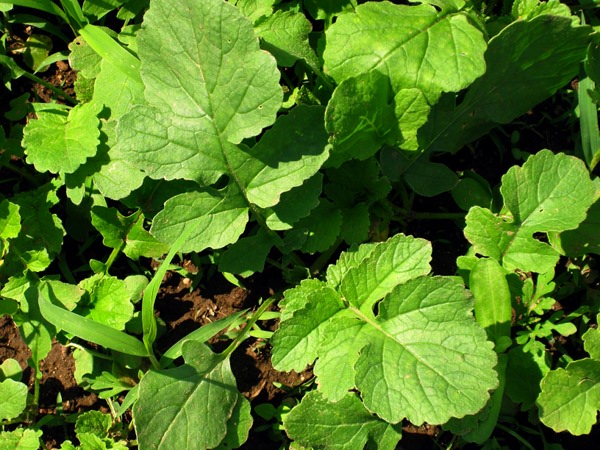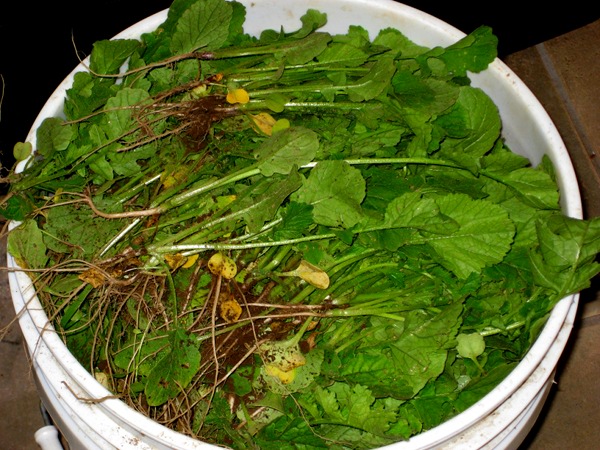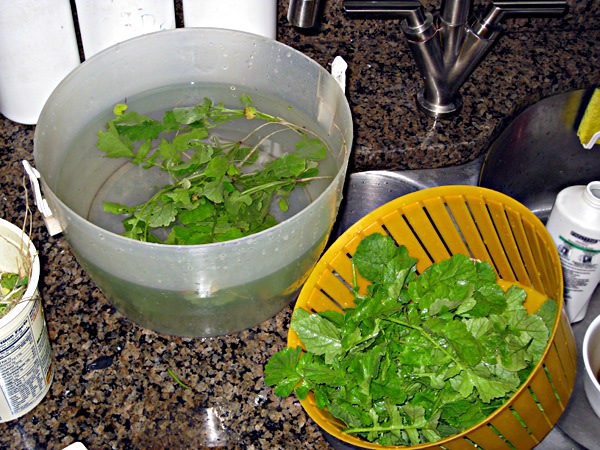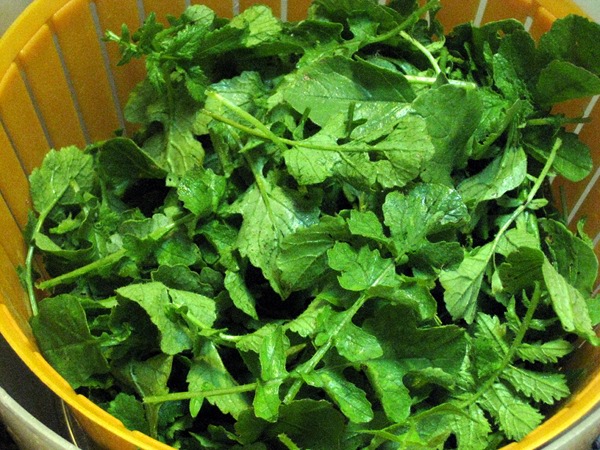The First Harvest of the Season, a Tasty Weed
Ted Ruegsegger, to my fellow gardeners at the Wilbraham Community Garden at Thayer Brook, 9 June 2010
Discovery
After the many rainstorms we had, I was at first dismayed to find my entire plot thickly covered with weeds. It took me a couple of visits just to clear my paths while the sun beat down.
When I finally got around to weeding the beds, though, it was a different story. The rains had made the soil soft and easily workable and pulling the weeds was a fairly simple, if time-consuming, affair. In my case, most of my beds were planted with seeds, relatively few of which had made themselves known as identifiable sprouts, so I had to weed carefully.
We all know how it feels to get into the rhythm of weeding. We daydream, meditate, whistle, sing, or whatever most pleasantly occupies our minds while only a small part of our consciousness focuses on what to pull and what not to pull. Well, somewhere along the line I noticed that the dominant weed in my plot and in many, but not all, of my neighbors' is a brassica, that is, a plant in the big family that includes cabbage, cauliflower, broccoli, turnips, radishes, mustard, kale, kohlrabi, Brussels sprouts, rapeseed (canola), and so on. Reflecting that just about all brassicas are edible and most are good-tasting, I nibbled a leaf or two, then ate a few more. Not half bad!

Epiphany
Today I came back to do some more weeding and it hit me: this is my first crop, and all I have to do is harvest it! While growing, it served admirably as a cover crop, its broad leaves shading out its competitors so that there are relatively few other weeds. Yeah, that means it probably shaded out a lot of my intentionally-planted seeds but hey, nothing's free. It's easily pulled; just wrap a finger or two around the rosette of toothed, slightly hairy leaves and lift it out, root and all. I grabbed a big bucket and started throwing the brassica (I'm going to call it wild mustard until someone who knows more about plant identification can set me straight) into it.
Nimiety

Oops, as sometimes happens with gardening, a huge overabundance. A single 4ft x 8ft bed easily filled the bucket, even packed down. The return of rain interrupted my weeding at this opportune moment, so I took my bucket home and started experimenting.
Cookery
Here's what worked for me:
Cleaning and preparation:

A salad spinner (a big bowl with a colander that fits inside and can be cranked to spin) came in handy for this step. I filled the bowl with mustard and a lot of water, then took individual mustard plants and pinched off the leafy parts with a thumbnail. Those parts went into the colander, conveniently resting in the sink, while the roots and stems went into the compost bucket.
Once the greens in the bowl had soaked for a while, I poured off the now-dirty water (the rains had splashed a lot of soil all over the foliage) and added fresh water so that the plants were mostly clean by the time I lifted them out to harvest the leaves.
When the bowl was empty, I put the colander part with the leafy greens into it and rinsed it all again to get the last of the dirt off, then spun it to drain off all the water.

Salad green:
Throw it into a salad bowl with your favorite dressing (bear in mind these greens don't taste like lettuce, so try a few to see what you like best; in my case it's Ken's Italian). I loved it, but then I also love turnip greens and kale. My wife was slightly less enthusiastic but allowed that it would mix well with other greens.
The flavor is slightly stronger than cabbage but milder than, say, broccoli. Mustard greens you might buy or grow yourself probably taste strong (I had some once that actually tasted like Dijon mustard) but bear in mind they were carefully bred and selected for that flavor. These wild weeds were naturally selected according to the usual evolutionary criteria, namely their ability to survive and reproduce. By now we're all aware they're very good at that!
If anything, the texture delights me even more than the flavor.
Beans and Greens
Open a 15-oz can of lima beans, pour the liquid into a microwavable bowl, fill it with mustard greens (packed), throw in a bouillon cube for good measure, and microwave it covered for several minutes. Then add the beans and nuke it for a couple more.
Quick, easy, tasty and satisfying.
Quiche
Make your favorite quiche recipe and add chopped mustard greens where you might otherwise have used spinach. Our mustard, cheese and sausage quiche turned out so delicious I've resolved to collect and freeze as much of the mustard as I possibly can.
Other Ideas
That's what I've tried so far, but other recipes readily suggest themselves:
- Sandwich green: where you might use lettuce, use mustard instead for a stronger flavor and an interesting texture.
- Mixed green salad: in salads along with lettuce, arugula, rocket, or the many "mixed greens" available in stores.
- Potherb: toss a handful into a hot, lightly-oiled skillet. Optionally, add some strong-flavored sausage like chourišo (fellow gardener Dave's suggestion). An early step in preparing the mustard, cheese and sausage quiche was to sautÚ garlic, onions, mushrooms and peppers in butter and then, once they're nicely done, add the mustard which cooks much faster. This would have been a tasty side dish in its own right.
As I try new combinations, I'll update this page with what works and what doesn't. If you have any suggestions, recipes or comments, please let me know, in person or via email.